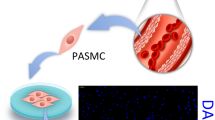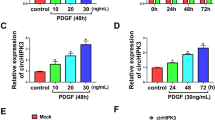Abstract
In this study, we developed an adenoviral vector harboring calpain-2 siRNA expression unit in which sense and anti-sense strands composing the siRNA duplex were connected by a loop and transcribed into a siRNA in porcine pulmonary artery endothelial cells (PAEC). We screened one efficient adenoviral vector Ad/si-m187 and found that Ad/si-m187 successfully exerted a gene knockdown effect on calpain-2 mRNA transcription and protein expression levels. The protein content of calpain-2 was reduced by 30%–80% in PAEC infected with Ad/si-m187 in comparison to a control adenoviral vector Ad/si-luc. The mRNA levels of calpain-2 were measured by real-time PCR and were decreased by 60%–100% and in a dose dependent manner. In correspondence to silencing calpain-2 gene expression, calpain-2 activity was decreased significantly. We further evaluated the role of calpain-2 in endothelial cell migration and proliferation. PAEC infected with Ad/si-m187 displayed impaired migration and cell proliferation in comparison to cells infected with control adenoviral vector (Ad/si-luc). These results indicate that adenoviral vector harboring calpain-2 siRNA expression unit is a valuable tool to study the biology of calpains and that calpain-2 plays an important role in lung endothelial cell migration and proliferation.
Similar content being viewed by others
References
Sorimachi H, Suzuki K: The structure of calpain. J Biochem (Tokyo) 129: 653–664, 2001
Suzuki K, Hata S, Kawabata Y, Sorimachi H: Structure, activation, and biology of calpain. Diabetes 53 (Suppl 1): S12–S18, 2004
Zhang J, Patel JM, Block ER: Hypoxia-specific upregulation of calpain activity and gene expression in pulmonary artery endothelial cells. Am J Physiol 275: L461–L468, 1998
Carragher NO, Frame MC: Calpain: A role in cell transformation and migration. Int J Biochem Cell Biol 34: 1539–1543, 2002
Branca D: Calpain-related diseases. Biochem Biophys Res Commun 322: 1098–1104, 2004
Shiraha H, Glading A, Chou J, Jia Z, Wells A: Activation of m-calpain (calpain II) by epidermal growth factor is limited by protein kinase A phosphorylation of m-calpain. Mol Cell Biol 22: 2716–2727, 2002
Goll DE, Thompson VF, Li H, Wei W, Cong J: The calpain system. Physiol Rev 83: 731–801, 2003
Huang Y, Wang KK: The calpain family and human disease. Trends Mol Med 7: 355–362, 2001
Franco S, Perrin B, Huttenlocher A: Isoform specific function of calpain 2 in regulating membrane protrusion. Exp Cell Res 299: 179–187, 2004
Glading A, Lauffenburger DA, Wells A: Cutting to the chase: Calpain proteases in cell motility. Trends Cell Biol 12: 46–54, 2002
Huttenlocher A, Palecek SP, Lu Q, Zhang W, Mellgren RL, Lauffenburger DA, Ginsberg MH, Horwitz AF: Regulation of cell migration by the calcium-dependent protease calpain. J Biol Chem 272: 32719–32722, 1997
Janossy J, Ubezio P, Apati A, Magocsi M, Tompa P, Friedrich P: Calpain as a multi-site regulator of cell cycle. Biochem Pharmacol 67: 1513–1521, 2004
Sato K, Kawashima S: Calpain function in the modulation of signal transduction molecules. Biol Chem 382: 743–751, 2001
Donkor IO: A survey of calpain inhibitors. Curr Med Chem 7: 1171–1188, 2000
Shen C, Buck AK, Liu X, Winkler M, Reske SN: Gene silencing by adenovirus-delivered siRNA. FEBS Lett 539: 111–114, 2003
Edgell CJ, Curiel DT, Hu PC, Marr HS: Efficient gene transfer to human endothelial cells using DNA complexed to adenovirus particles. Biotechniques 25: 264–2, 1998
Perrin BJ, Amann KJ, Huttenlocher A: Proteolysis of cortactin by calpain regulates membrane protrusion during cell migration. Mol Biol Cell 17: 239–250, 2006
Gratton JP, Yu J, Griffith JW, Babbitt RW, Scotland RS, Hickey R, Giordano FJ, Sessa WC: Cell-permeable peptides improve cellular uptake and therapeutic gene delivery of replication-deficient viruses in cells and in vivo. Nat Med 9: 357–362, 2003
Su Y, Block ER: Acute hypoxia increases intracellular L-arginine content in cultured porcine pulmonary artery endothelial cells. J Cell Physiol 167: 349–353, 1996
Su Y, Cao W, Han Z, Block ER: Cigarette smoke extract inhibits angiogenesis of pulmonary artery endothelial cells: The role of calpain. Am J Physiol Lung Cell Mol Physiol 287: L794–L800, 2004
Newcomb JK, Pike BR, Zhao X, Hayes RL: Concurrent assessment of calpain and caspase-3 activity by means of western blots of protease-specific spectrin breakdown products. Methods Mol Biol 144: 219–223, 2000
Aepfelbacher M, Essler M, Huber E, Sugai M, Weber PC: Bacterial toxins block endothelial wound repair. Evidence that Rho GTPases control cytoskeletal rearrangements in migrating endothelial cells. Arterioscler Thromb Vasc Biol 17: 1623–1629, 1997
Hammond SM, Caudy AA, Hannon GJ: Post-transcriptional gene silencing by double-stranded RNA. Nat Rev Genet 2: 110–119, 2001
Arts GJ, Langemeijer E, Tissingh R, Ma L, Pavliska H, Dokic K, Dooijes R, Mesic E, Clasen R, Michiels F, van der SJ, Lambrecht M, Herman S, Brys R, Thys K, Hoffmann M, Tomme P, van Es H: Adenoviral vectors expressing siRNAs for discovery and validation of gene function. Genome Res 13: 2325–2332, 2003
Bain JR, Schisler JC, Takeuchi K, Newgard CB, Becker TC: An adenovirus vector for efficient RNA interference-mediated suppression of target genes in insulinoma cells and pancreatic islets of langerhans. Diabetes 53: 2190–2194, 2004
Achenbach TV, Brunner B, Heermeier K: Oligonucleotide-based knockdown technologies: Antisense versus RNA interference. Chembiochem 4: 928–935, 2003
Vickers TA, Koo S, Bennett CF, Crooke ST, Dean NM, Baker BF: Efficient reduction of target RNAs by small interfering RNA and RNase H-dependent antisense agents. A comparative analysis. J Biol Chem 278: 7108–7118, 2003
Bilanges B, Stokoe D: Direct comparison of the specificity of gene silencing using antisense oligonucleotides and RNAi. Biochem J 388: 573–583, 2005
Zhang W, Lane RD, Mellgren RL: The major calpain isozymes are long-lived proteins. Design of an antisense strategy for calpain depletion in cultured cells. J Biol Chem 271: 18825–18830, 1996
Elbashir SM, Martinez J, Patkaniowska A, Lendeckel W, Tuschl T: Functional anatomy of siRNAs for mediating efficient RNAi in Drosophila melanogaster embryo lysate. EMBO J 20: 6877–6888, 2001
Hutvagner G, Zamore PD: A microRNA in a multiple-turnover RNAi enzyme complex. Science 297: 2056–2060, 2002
Jackson AL, Bartz SR, Schelter J, Kobayashi SV, Burchard J, Mao M, Li B, Cavet G, Linsley PS: Expression profiling reveals off-target gene regulation by RNAi. Nat Biotechnol 21: 635–637, 2003
Semizarov D, Frost L, Sarthy A, Kroeger P, Halbert DN, Fesik SW: Specificity of short interfering RNA determined through gene expression signatures. Proc Natl Acad Sci U S A 100: 6347–6352, 2003
Hamada M, Ohtsuka T, Kawaida R, Koizumi M, Morita K, Furukawa H, Imanishi T, Miyagishi M, Taira K: Effects on RNA interference in gene expression (RNAi) in cultured mammalian cells of mismatches and the introduction of chemical modifications at the 3′-ends of siRNAs. Antisense Nucleic Acid Drug Dev 12: 301–309, 2002
Bartel DP: MicroRNAs: Genomics, biogenesis, mechanism, and function. Cell 116: 281–297, 2004
Perrin BJ, Huttenlocher A: Calpain. Int J Biochem Cell Biol 34: 722–725, 2002
Author information
Authors and Affiliations
Corresponding author
Rights and permissions
About this article
Cite this article
Qiu, K., Su, Y. & Block, E.R. Use of recombinant calpain-2 siRNA adenovirus to assess calpain-2 modulation of lung endothelial cell migration and proliferation. Mol Cell Biochem 292, 69–78 (2006). https://doi.org/10.1007/s11010-006-9219-2
Received:
Accepted:
Published:
Issue Date:
DOI: https://doi.org/10.1007/s11010-006-9219-2




